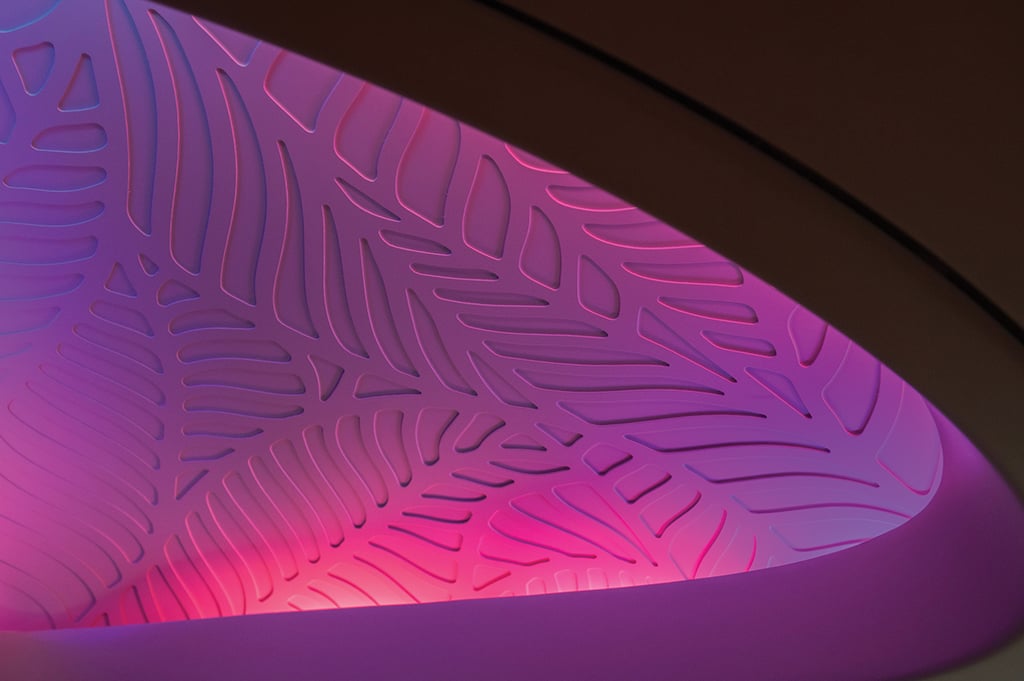
Hawaiian Airline’s newest premium product, Leihōkū Suites, was designed to evoke the natural beauty of the islands.
When airlines select an aircraft type, there are many factors to consider, such as lease or purchase, target routes and fleet commonality—but what goes into selecting the cabin design?
Design consultancy Teague senior director-airline experience Anthony Harcup told ATW on the sidelines of the Aircraft Interiors Expo in Hamburg that designers are looking for the meaning and purpose of the interior, as well as what defines the brand in terms of passenger service.
Seattle-based Teague, working with Adient Aerospace, was the designer behind Hawaiian Airlines’ Boeing 787-9 interior and new class of premium service, Leihōkū Suites, which is scheduled to be introduced in 2024 on select routes.
“When we work with an airline, we usually spend a few months really getting to know them at the beginning of the program; it’s like the strategy phase. We’re trying to understand why they’re doing what they’re doing,” Harcup said, adding it is different for each airline.
“They’re like people; they’ve all got a different reason for being successful—especially a flag carrier. There’s usually a very strong identity to their region and a uniquely identifiable way of connecting with their passengers.”
Adient Aerospace said the company started working with Hawaiian Airlines and Teague on this design in 2018 to launch the new 787-9 business-class seats, which was postponed by the pandemic and then by 787 delivery delays.

“There was a genuine, collaborative effort during the early development days of the design, and it was great working together with Teague to successfully bring Hawaiian’s vision to life,” an Adient spokesperson told ATW. “Hawaiian Airlines is Adient Aerospace’s very first customer, and the launch customer for our 787 Ascent business-class seat.”
Hawaiian says passengers who fly its new 787s with the Leihōkū Suites will be “immersed in cabin design elements that evoke Hawaii’s rich natural world through bold textures, island-inspired sunrise, sunset lighting, and sinuous ocean and wind patterns.”
Essentially, the airline wants to give a sense of arriving at the Pacific islands from the moment of boarding.
UNDER THE SKIN
“[Designing an aircraft interior] is getting under the skin of the local culture and behind the DNA of the brand,” Harcup explained. “We talked to all the stakeholders across Hawaiian—we interviewed them and all the different departments to figure out what the cultural immersion is like when we visit there and we found there are so many unique identifiers, such as the beauty of the island and the people.”
Harcup said that as designers talked with Hawaiian, the theme of voyaging became a really strong part of their identity.
“Like the Polynesian voyagers who used to go out on vessels to discover new territories … it suddenly put a whole different lens on the landscape, because they would use the sun in the day and the various star constellations at night to orient themselves when they’re out on voyages. Those things played a really strong role in the design.”
Harcup said five main themes appear everywhere within the interior: the sun, stars, ocean, wind and wildlife, with a unique range of flora and fauna on the islands.
“The starry night is actually part of the reason that’s called Leihōkū because it’s Hawaiian for ‘garland or lei of stars.’ A garland is something you wear and when you get into this business class and close the door, you feel like you’re wrapped in stars because the stars are projected up on the ceiling. It’s really beautiful,” he said.
Adient added, “It was evident from the beginning that Hawaiian was very passionate about their culture and branding, and making sure that this came through in the design language and for the passenger experience. We used Hawaiian-centric materials to make Ascent look and feel Hawaiian through the CMF [color, material and finish] palette developed with Teague. It was so rewarding to bring this vision collaboratively to life and see it realized in the delivered product.”
FUNCTION AND BEAUTY
“The intent behind every design choice was really important,” Hawaiian Airlines senior director, brand and community Alisa Onishi said in a Hawaiian-produced video. “Things have to function, but also have to look beautiful. And so, it’s a team of our product development folks, our engineers on the Boeing teams, as well as our friends from Teague, who helped interpret our design brief into actual materials, surfaces and structures that would function on the airplane.”

Teague design manager Loreto Julian, who is from Hawaii and has an understanding of what is special about the place and culture, said the ocean has a wave form, color saturation and gradient to it.
“So, as you’re walking down the carpet, you’ll see the wave forms kind of transform on the carpet,” he said. “[In Hawaii] I remember sitting under trees and watching the shadows that would appear in front of me, so wallpaper on the walls is going to be different and each one indicates a different shadow that you might experience in Hawaii.”
Harcup concludes: “It’s like a little piece of Hawaii has just come to pick you up and lets you know what you’re in for. Flag carriers are almost like unofficial ambassadors of the country, and if you’re from Hawaii, you get the feeling that you’re at home already when you get on the aircraft. If you’re a tourist, you feel you are already on holiday when you board. There’s something really nice about that.”





